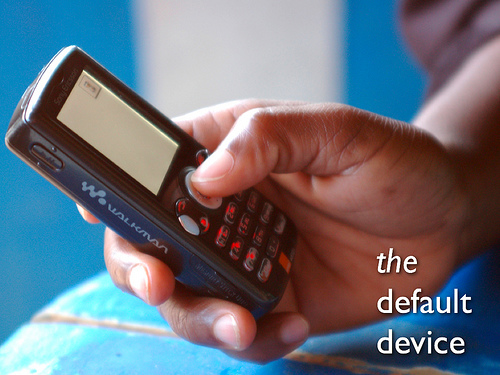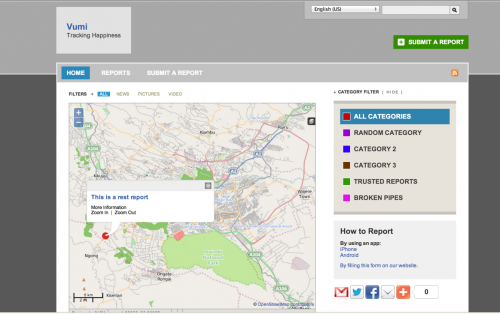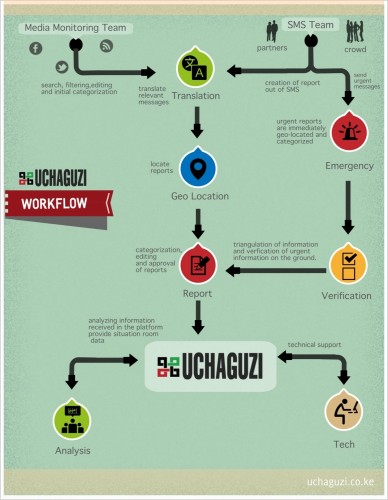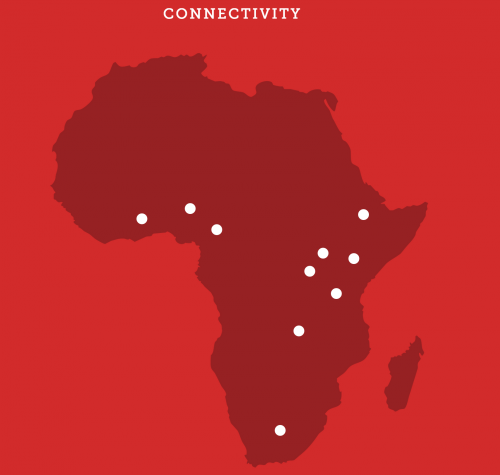The mobile phone has been at the core of Ushahidi's strategy when building tools for citizen engagement. Its ubiquitous nature makes it the easiest tool to use and ensure that a vast majority of citizens can actively participate. We've seen this to be the case in many past Ushahidi deployments, such as Uchaguzi( deployment to monitor the 2013 kenyan general elections). Most of the reports that came into the platform during that time were largely from mobile phones.
 Even as we ship out newer versions of our products and build others for use during emergencies, we maintain a mobile first approach.
Even as we ship out newer versions of our products and build others for use during emergencies, we maintain a mobile first approach.
 At the moment, this service is running on one of Praekelt's shortcodes on Airtel, one of Kenya's telephone service providers.
At the moment, this service is running on one of Praekelt's shortcodes on Airtel, one of Kenya's telephone service providers.
 Uchaguzi workflow[/caption]
Here's a look into the workflow of the team managing incoming SMSes for Uchaguzi. Nonetheless, we still had to shift over lots of volunteers to manage the flood of SMSes that were coming in, and sifting through messages that were relevant and those that were not was still a big problem.
This USSD app could go a long way in reducing the amount of time it takes to process reports that come in via SMS, through the simple structure it provides.
Uchaguzi workflow[/caption]
Here's a look into the workflow of the team managing incoming SMSes for Uchaguzi. Nonetheless, we still had to shift over lots of volunteers to manage the flood of SMSes that were coming in, and sifting through messages that were relevant and those that were not was still a big problem.
This USSD app could go a long way in reducing the amount of time it takes to process reports that come in via SMS, through the simple structure it provides.
 Vumi Connectivity Map[/caption]
For more information, visit the Vumi Connectivity map.
Vumi Connectivity Map[/caption]
For more information, visit the Vumi Connectivity map.
 Even as we ship out newer versions of our products and build others for use during emergencies, we maintain a mobile first approach.
Even as we ship out newer versions of our products and build others for use during emergencies, we maintain a mobile first approach.
What is USSD
USSD is something that isn't foreign to mobile phone users in Africa. Its a service that is interacted with, probably, on a daily basis. In Kenya, we use it to reload prepaid phones with airtime, or even subscribe for data bundles. USSD is largely used for menu-based information services, prepaid callback services and mobile-money services. USSD, which stands for Unstructured Supplementary Services Data, is a protocol that allows for the transmission of information via a GSM network.How does it work?
Users enter a USSD string and press call to send the message. A typical USSD message starts with a * followed by digits which indicate an action to be performed or are parameters. Each group of numbers is separated by a *, and the message is terminated with a #. For example, in Kenya, to find out what your airtime balance is on Safaricom, a user will dial *144#. Unlike SMS, USSD messages create a real-time connection during a session, that remains open, allowing a two-way exchange of a sequence of data.Ushahidi via USSD
We recently came across a tool built by our good friends from the Praekelt foundation running on Vumi, an agnostic mobile messaging platform that serves both NGO and commercial clients in Africa. Simon de Haan, a chief Engineer at Praekelt, whipped up a quick application (on a two hour flight) that allows for users to send in reports to ushahidi deployments via USSD. All his code is available on his github repository, and has been open sourced. This application sends reports via Ushahidi's REST API, and works with Classic Crowdmap deployments. Here's a short demo of how it works with Simon's test deployment on Crowdmap. From here, this report is directed into the deployment for report approval, and subsequently appears on the main map At the moment, this service is running on one of Praekelt's shortcodes on Airtel, one of Kenya's telephone service providers.
At the moment, this service is running on one of Praekelt's shortcodes on Airtel, one of Kenya's telephone service providers.
Why is this SO mindblowing?
Getting clean data from SMS has been a huge challenge when processing information coming into ushahidi deployments. Admins have to manually extract report locations and descriptions from SMSes received (assuming this information is provided). The information processing workflow for uchaguzi was structured in a manner to help mitigate some of the challenges mentioned above. [caption id="attachment_14256" align="aligncenter" width="388"] Uchaguzi workflow[/caption]
Here's a look into the workflow of the team managing incoming SMSes for Uchaguzi. Nonetheless, we still had to shift over lots of volunteers to manage the flood of SMSes that were coming in, and sifting through messages that were relevant and those that were not was still a big problem.
This USSD app could go a long way in reducing the amount of time it takes to process reports that come in via SMS, through the simple structure it provides.
Uchaguzi workflow[/caption]
Here's a look into the workflow of the team managing incoming SMSes for Uchaguzi. Nonetheless, we still had to shift over lots of volunteers to manage the flood of SMSes that were coming in, and sifting through messages that were relevant and those that were not was still a big problem.
This USSD app could go a long way in reducing the amount of time it takes to process reports that come in via SMS, through the simple structure it provides.
Where is this service available?
Vumi connectivity is available in the following countries:-- Zambia - USSD
- Nigeria - USSD
- Kenya - SMS Shortcode/USSD
- Tanzania - SMS Shortcode/USSD
- South Africa – SMS Shortcode/USSD
- Ghana - SMS Shortcode
- Cameroon - SMS Shortcode
- Rwanda - SMS Shortcode
- Uganda - SMS Shortcode
- Ethiopia - SMS Shortcode
 Vumi Connectivity Map[/caption]
For more information, visit the Vumi Connectivity map.
Vumi Connectivity Map[/caption]
For more information, visit the Vumi Connectivity map.